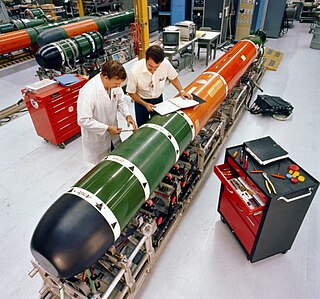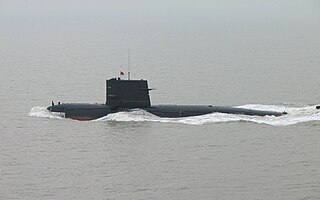
A modern torpedo is a self-propelled weapon with an explosive warhead, launched above or below the water surface, propelled underwater towards a target, and designed to detonate either on contact with its target or in proximity to it.

The Mark 48 and its improved Advanced Capability (ADCAP) variant are American heavyweight submarine-launched torpedoes. They were designed to sink deep-diving nuclear-powered submarines and high-performance surface ships.

USS Torsk (SS-423) is a Tench-class submarine built for the United States Navy during World War II. Armed with ten torpedo tubes, the Tench-class submarines were incremental developments of the highly-successful Gato-class submarines that formed the backbone of the US Navy's submarine force during the war. Torsk was laid down at the Portsmouth Navy Yard in June 1944, was launched in September that year, and commissioned in December.

The United States' S-class submarines, often simply called S-boats, were the first class of submarines with a significant number built to United States Navy designs. Others of this class were built to contractor designs.

The Mark 54 Lightweight Torpedo is a standard 12.75 inch (324 mm) anti-submarine warfare (ASW) torpedo used by the United States Navy.

The Sting Ray torpedo is a current British acoustic homing light-weight torpedo (LWT) manufactured by GEC-Marconi, who were later bought out by BAE Systems. It entered service in 1983.

The Mark 44 torpedo is a now-obsolete air-launched and ship-launched lightweight torpedo manufactured in the United States, and under licence in Canada, France, Italy, Japan and the United Kingdom, with 10,500 being produced for U.S. service. It was superseded by the Mark 46 torpedo, beginning in the late 1960s. The Royal Australian Navy, however, continued to use it alongside its successor for a number of years, because the Mark 44 was thought to have superior performance in certain shallow-water conditions.

The Mark 24 mine is an air-dropped passive acoustic homing anti-submarine torpedo used by the United States during the Second World War. It entered service in March 1943 and remained in use with the US Navy until 1948. Approximately 4,000 torpedoes were produced, with 204 ultimately being deployed during the war. As a result of its use, 37 Axis submarines were sunk and a further 18 were damaged. The torpedo was also supplied to the British and Canadian forces. The deceptive name of "Mark 24 Mine" was deliberately chosen for security purposes, to conceal the true nature of the weapon.

The Mark 37 torpedo is a torpedo with electrical propulsion, developed for the US Navy after World War II. It entered service with the US Navy in the early 1950s, with over 3,300 produced. It was phased out of service with the US Navy during the 1970s, and the stockpiles were sold to foreign navies.

The Type 039 submarine is a class of diesel-electric submarines of the People's Liberation Army Navy. The class is the first diesel-electric submarine to be fully developed within China and also the first Chinese diesel-electric submarine to use the modern teardrop hull shape.

An aerial torpedo, airborne torpedo or air-dropped torpedo is a naval weapon, a torpedo, that an aircraft—fixed-wing aircraft or helicopter—drops in the water, after which the weapon propels itself to the target. First used in World War I, air-dropped torpedoes were used extensively in World War II, and remain in limited use. Aerial torpedoes are generally smaller and lighter than submarine- and surface-launched torpedoes.

The Mark 14 torpedo was the United States Navy's standard submarine-launched anti-ship torpedo of World War II. This weapon was plagued with many problems which crippled its performance early in the war. It was supplemented by the Mark 18 electric torpedo in the last two years of the war. Nonetheless, the Mark 14 played a major role in the devastating blow U.S. Navy submarines dealt to the Japanese naval and merchant marine forces during the Pacific War.

The Mark 18 torpedo was an electric torpedo used by the United States Navy during World War II. The Mark 18 was the first electric storage battery torpedo manufactured for the US Navy and it was designed primarily for use as a submarine-launched torpedo.
There have been a number of 18-inch torpedoes in service with the United Kingdom.
There have been several British 21-inch (533 mm) diameter torpedoes used by the Royal Navy since their first development just before the First World War.
The Mark 21 torpedo, designated Mark 21 Mod 0 was a passive acoustic homing torpedo designed in 1943 by Westinghouse Electric Corporation. The Mark 21 successfully passed launching tests in 1943, however, due to difficulties encountered by Westinghouse, the project was abandoned after a few development models had been built.
The Mark 26 torpedo was a submarine-launched anti-surface ship torpedo designed by Westinghouse Electric in 1944 as an improved version of the Mark 28 torpedo.
The Mark 29 torpedo was a submarine-launched, acoustic torpedo designed by Westinghouse Electric in 1945 for the United States Navy. It used the same acoustic system as the Mark 28 torpedo but was faster, operated at various depths, had an external depth setter, and could run as either a straight or a homing torpedo. The Mod 1 variant had two speeds, a remote-setting variable enabler and an anti-circular run device.
The Mark 31 torpedo was a destroyer-launched acoustic torpedo developed by the Harvard and Pennsylvania State universities during World War II. A modification of the Mark 18 electric torpedo, it was conceived as an interim weapon to be used in the Pacific War until a new high-speed acoustic torpedo could be developed for the United States Navy.
The Mark 36 torpedo was a submarine-launched Anti-surface ship torpedo designed by General Electric and the Naval Torpedo Station in 1946. Further development of the Mark 36 was discontinued due to the development of the Mark 42 torpedo.















